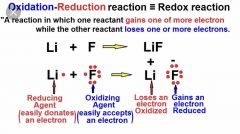![]()
![]()
![]()
Use LEFT and RIGHT arrow keys to navigate between flashcards;
Use UP and DOWN arrow keys to flip the card;
H to show hint;
A reads text to speech;
8 Cards in this Set
- Front
- Back
- 3rd side (hint)
|
What is the equation for when metals react with water ? |
Metal + Water— Metal hydroxide + Hydrogen |
Lithium + water — lithium hydroxide + hydrogen |
|
|
What is a displacement reaction |
More reactive metals takes the place of a less reactive element , in solutions or in its compounds |
Knocking something over |
|
|
What’s the reactivity series from highest to lowest ? |
Please Potassium Stop. Sodium Calling. Calcium Me. Magnesium A. Aluminium Careless carbon Zebra. Zinc Instead. Iron Try. Tin Learning. Lead How. Hydrogen Copper Copper Saves Silver Gold Gold |
|
|
|
What’s reduction , reactivity series , ore , native , oxidation |
Reactivity series: a list of elements from most to lest reactive Ore: a rock containing enough metal to make it economic to extract Native metals : un-reactive metals found in their element state . Solid form Reduction is the process of gaining one or more electrons. In an oxidation-reduction, or redox, reaction, one atom or compound will steal electrons from another atom or compound. A classic example of a redox reaction is rusting. When rusting happens, oxygen steals electrons |

Oil rig Oxidation is loss , reduction is gain |
|
|
Ph scale |
1-14 1-6 is acids 7 is neutral 8-14 is alkaline |
|
|
|
Metals and acids |
Reaction between metals and acids can only occur when the metal is more reactive than the hydrogen in the acid |
|
|
|
Equation for metals and acids reacting : |
Metal + acids — a salt + hydrogen |
|
|
|
Some equations for metals and acids |
Acid + metal— a salt + hydrogen Acid + metal oxide—salt + water Acid + metal carbonate — salt + water + carbon dioxide Acids are defined as proton donors . This means they release h+ ions into solutions Acids are also compounds dissolved in water that produce a solution with a ph lower than 1 |
|

